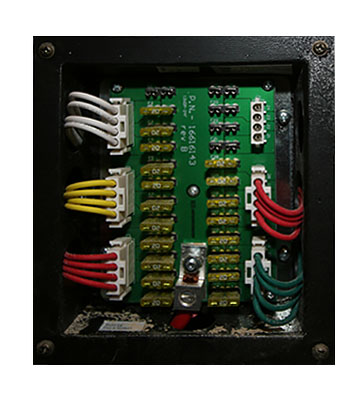RV Electrical System Failure
Sometimes these systems can fail, not that this will come as a shock to anyone. When electrical systems fail it’s time to do some testing to see where the failure is. A voltmeter is a huge help in this area although a test light can also be used to test low voltage circuits. Personally, if you are a motorhome owner you should have a multi-meter of some sort. It’s invaluable for checking high voltage circuits, campground pedestals, low voltage circuits, and continuity.
Fuse panels hold fuses for all 12-volt systems
Check for Blown Fuses
The first thing to do is to check for blown fuses. Sometimes you can do this by removing the fuse and holding it up to the light to determine if the fusible link is blown. Sometimes it’s not so easy to see. The way many of these fuse panels are labeled, or more accurately, “not” labeled, you may have trouble figuring out which fuse does what. The common ATO fuses are blade type fuses with a plastic housing. There are bare spots on the end of the housing that can be used to test for voltage. If you have power going into the fuse, but not out of it, you’ll know you have a bad fuse. Another method is to use the ohms setting on a multimeter. Remove the fuse and check for continuity with the meter. If there is no continuity, the fuse is bad. If you have a critical circuit you can also replace those fuses with ATO style circuit breakers that plug right into place. There are also fuses with LED pilot lights that will illuminate if the fuse is blown. So, you have lots of options when it comes to fuses.
Test for Voltage
If it’s not a fuse, then you need to look a little deeper. If the fuse does have power leaving it, test for voltage at the device that isn’t working. If you have power coming into the device, it’s either a bad device (light bulb, fan motor, water pump, etc.) or else you do not have a complete circuit. In that case, I’d check for a bad ground because an open ground won’t provide a complete circuit back to the battery. If you do not have power at the device, there is an open circuit between the fuse and the device. The first place to look would be at the switch. Test to see if there is power coming into the switch and power exiting the switch. If the power is getting to the switch but not leaving it, it’s time to replace the switch.
| Wire Gauge (AWG) | Wire Diameter, in Inches | Current Capacity, in Amps |
|---|---|---|
| 0000 | .4600 | 600 |
| 000 | .4096 | 500 |
| 00 | .3648 | 400 |
| 0 | .3249 | 320 |
| 1 | .2893 | 250 |
| 2 | .2576 | 200 |
| 4 | .2043 | 125 |
| 5 | .1819 | 100 |
| 6 | .1620 | 65-80 |
| 8 | .1285 | 40-50 |
| 10 | .1019 | 30-33 |
| 12 | .0808 | 20-23 |
| 14 | .0641 | 15-17 |
| 16 | .0508 | 7.5-10 |
| 18 | .0403 | 5 |
| 20 | .0320 | 3.3 |
| 24 | .0201 | 1.3 |
| 28 | .0126 | 0.5 |
This chart shows the current capacity for various wire gauge sizes


